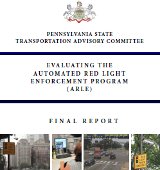Article from: www.thenewspaper.com/news/38/3863.asp
8/8/2012
Pennsylvania Red Light Camera Violations Have Not Decreased.
Claims regarding violations and accidents at red light camera locations fail to hold up to scrutiny.
 Pennsylvania Governor Tom Corbett last month signed legislation expanding the use of red light cameras throughout the state. The state House waited until the dead of night to pass the measure giving jurisdictions with populations greater than 20,000 the ability to install automated ticketing machines, hoping to generate an estimated $49,502,545 in revenue in the first year.
Pennsylvania Governor Tom Corbett last month signed legislation expanding the use of red light cameras throughout the state. The state House waited until the dead of night to pass the measure giving jurisdictions with populations greater than 20,000 the ability to install automated ticketing machines, hoping to generate an estimated $49,502,545 in revenue in the first year.
The legislation was adopted in large measure because of a positive report released in October 2011 from the Pennsylvania State Transportation Advisory Committee. With a membership consisting primarily of state and local officials, the committee offered a glowing general endorsement of the use of cameras that, until now, were only allowed in Philadelphia.
"There are several indicators that demonstrate the Automated Red Light Enforcement (ARLE) program has improved safety related to red light running," the report concluded. "A review of the operational intersections indicates that the program has successfully reduced red light running violations by an average of 48 percent within the first 12 months of enforcement. The total number of crashes has also declined by 24 percent for the 10 ARLE intersections where three years of crash data after ARLE's commencement is available."
A more thorough analysis of the data raises questions about these two conclusions drawn by the committee regarding the number of violations and the number of accidents. For example, although the number of violations may decrease between the warning period and the end of the first year of use, there is no significant year-to-year variation in ticketing levels when one accounts for the number of cameras in use. In 2008, the revenue generated per intersection-month of camera usage was $66,933. The following year, that figure did drop 4.7 percent to $63,768. Thereafter, it increased to $68,265 in 2010 and $71,876 in 2011. The amount of profit is so predictable that vendors and state officials can rely on a steady stream so long as new camera locations are introduced on a regular basis.
"As shown, the program now requires approximately 318 monthly violations per traffic signal (or 10.5 daily) in order to recoup the operation and maintenance costs at each intersection," the report explained. "This is an important issue in considering the potential expansion of the program to other areas of the state."
As for the safety impact, facts are far less clear. Out of nineteen camera enforced intersections, the report considered data for only ten intersections.
"Crash experiences for ARLE-controlled intersections varied significantly," the report explained. "Some intersections experienced an increase in overall, angle, and rear end crashes while the others experienced a decrease in overall and angle crashes and a slight increase in rear end crashes. Overall, total crashes declined by just over 24 percent with specific types of crashes also decreasing."
While this is cited as evidence of the benefit of camera use, the streets are not actually safer than they were without cameras. Accidents in the third year following camera installation are not actually lower than in the third year before the devices were ever installed. The committee also made no attempt to examine results at control intersections. Traffic accidents have declined nationwide to an all-time low -- including in states that do not allow photo enforcement. That lack of proven benefit has made the devices unpopular.
"In some areas of the country, red light cameras have been met with vociferous opposition, with some cameras being vandalized, stolen, or torn down altogether," the report explained. "In Philadelphia, PPA reports occasional problems with graffiti on the camera boxes and signs. PPA once had two cameras stolen by someone using a bucket truck. (The cameras were later found in a New York City pawn shop.)"
Philadelphia's response has been to spend $120,000 on media relations to improve the image of the profitable program. A copy of the report is available in a 3mb PDF file at the source ink below.
Source: Evaluating the Automated Red Light Enforcment (Pennsylvania State Transportation Advisory Committee, 11/1/2011)
Permanent Link for this item
Return to Front Page
 Pennsylvania Governor Tom Corbett last month signed legislation expanding the use of red light cameras throughout the state. The state House waited until the dead of night to pass the measure giving jurisdictions with populations greater than 20,000 the ability to install automated ticketing machines, hoping to generate an estimated $49,502,545 in revenue in the first year.
Pennsylvania Governor Tom Corbett last month signed legislation expanding the use of red light cameras throughout the state. The state House waited until the dead of night to pass the measure giving jurisdictions with populations greater than 20,000 the ability to install automated ticketing machines, hoping to generate an estimated $49,502,545 in revenue in the first year.